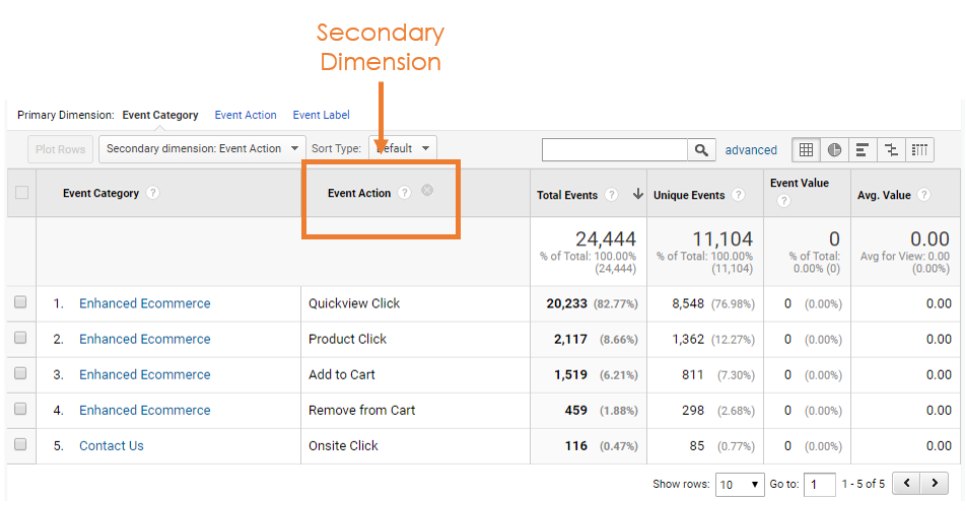Advanced Analytics Techniques: Leveraging Google Analytics Secondary Dimension
Opening the Power of Second Measurement Analytics for Boosted Information Insights and Decision-Making
In the world of data analytics, key measurements commonly take the spotlight, yet real deepness of insights exists within the world of additional dimensions. These additional data factors provide a nuanced point of view that can illuminate relationships and patterns not readily evident initially look. By using the power of second dimension analytics, companies can reveal covert trends, reveal correlations, and essence extra significant conclusions from their information. The possibility for boosted decision-making with the usage of these additional measurements is huge, promising a much deeper understanding of complicated data sets and leading the method for more enlightened critical choices.
Significance of Secondary Measurements
Checking out the importance of additional measurements in analytics introduces the covert layers of data insights important for informed decision-making in numerous domains. Secondary measurements offer a deeper understanding of main data by offering additional context and perspectives. By incorporating secondary dimensions right into analytics, companies can extract a lot more extensive and nuanced insights from their datasets.
One secret relevance of additional measurements is their ability to segment and categorize main information, permitting a much more detailed analysis of details subsets within a dataset. When looking at the information as a whole, this segmentation makes it possible for companies to determine patterns, fads, and outliers that could not be noticeable. Secondary dimensions help in revealing relationships and dependencies in between various variables, leading to more exact forecasting and predictive modeling - secondary dimension.
Furthermore, second dimensions play an essential role in boosting information visualization and coverage. By including secondary dimensions to visualizations, such as charts or graphes, analysts can develop extra informative and insightful representations of data, facilitating better communication of searchings for to stakeholders. Overall, the integration of second measurements in analytics is instrumental in opening the full capacity of data and driving evidence-based decision-making.
Key Advantages of Utilizing Second Measurements
Using additional measurements in analytics supplies companies a strategic benefit by increasing the deepness and granularity of data insights. By exploring data utilizing second dimensions such as time, area, gadget type, or customer demographics, organizations can discover patterns, patterns, and connections that may otherwise continue to be covert.
In addition, the application of second dimensions improves the context in which main information is analyzed. By leveraging additional measurements in analytics, companies can harness the full capacity of their information to drive much better decision-making and achieve their service purposes.
Advanced Information Analysis Strategies
A deep study innovative data analysis techniques reveals innovative approaches for drawing out important understandings from complicated datasets. One such strategy is artificial intelligence, where formulas are utilized to recognize patterns within information, forecast results, and make data-driven choices. This method enables the automation of logical version structure, enabling the handling of large volumes of data at a quicker rate than traditional methods.
One more sophisticated method is predictive analytics, which utilizes statistical algorithms and maker learning strategies to anticipate future end results based upon historic data. By examining patterns and trends, services can anticipate client actions, market fads, and possible risks, encouraging them to make positive choices.
Moreover, text mining and belief evaluation are important methods for extracting understandings from disorganized information sources such as social media comments, client evaluations, and survey responses. By analyzing text data, companies can understand client opinions, determine emerging patterns, and enhance their services or products based on responses.
Enhancing Decision-Making Through Second Dimensions

Enhancing decision-making with secondary dimensions enables services to make more notified and targeted calculated selections. As an example, by segmenting customer data based upon additional dimensions like acquiring history or involvement degrees, companies can customize their advertising methods to details target market sectors, resulting in boosted conversion rates and client satisfaction. Additionally, additional dimensions can assist identify correlations and connections between various variables, making it possible for organizations to make data-driven choices that drive growth and earnings.
Executing Secondary Measurement Analytics
When integrating secondary dimensions in analytics, organizations can unlock much deeper understandings that drive critical decision-making and enhance general performance. This entails recognizing the details inquiries the organization seeks to answer and the information factors needed to address them.

Additionally, organizations must utilize progressed analytics tools and technologies to improve the process of integrating additional measurements. These devices can automate data processing, evaluation, and visualization, permitting companies to concentrate on translating understandings instead of hand-operated data control.
Conclusion
In final thought, second measurement analytics play a vital function in enhancing data understandings and decision-making processes. By using innovative information evaluation strategies and applying additional dimensions properly, organizations can open the power of their data to drive critical service choices.
In the world of data analytics, primary dimensions frequently take the spotlight, yet the real depth of insights lies within the world of secondary dimensions.Making use of additional measurements in analytics offers organizations a tactical benefit by increasing the deepness and granularity of information insights. By leveraging additional measurements in analytics, organizations can harness the complete possibility of their data to drive much better decision-making and attain their service goals.
Implementing information validation procedures and regular audits can assist keep information high quality and integrity.
By utilizing sophisticated data evaluation techniques and applying additional measurements pop over to this site effectively, companies can open the power of their data to drive tactical company decisions.